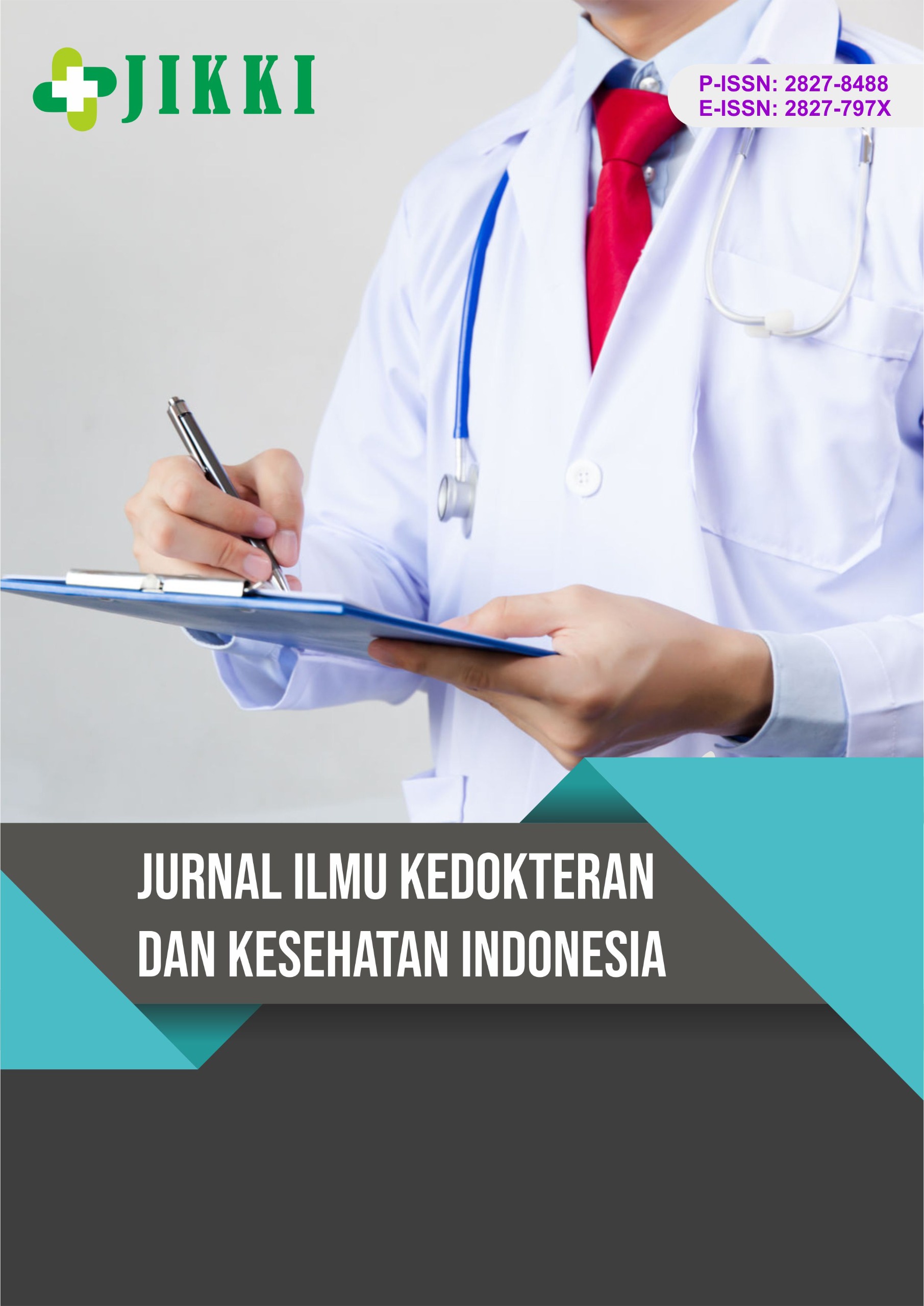Perbandingan Pemberian Cairan Koloid dengan Pemberian Terapi Obat Ephedrine dalam Mencegah Terjadinya Hipotensi Pasca Anestesi Spinal pada Pasien Sectio Caesarea di RSUD Ajibarang
DOI:
https://doi.org/10.55606/jikki.v5i3.8359Keywords:
Colloid Fluid, Ephedrine, Hypotension, Sectio Caesarea, Spinal AnesthesiaAbstract
Hypotension is one of the most common complications following spinal anesthesia, particularly in patients undergoing cesarean section. If not properly managed, it can lead to serious consequences such as nausea, vomiting, loss of consciousness, cardiovascular collapse, and decreased uteroplacental blood flow, which may endanger both the mother and fetus. Therefore, preventive measures are essential to ensure patient safety during surgery. This study aimed to compare the effectiveness of colloid fluid administration and intravenous ephedrine therapy in preventing hypotension after spinal anesthesia in cesarean section patients. This was a quantitative comparative study using a two-group pretest-posttest design, involving 80 respondents at RSUD Ajibarang. The subjects were divided into two intervention groups: one receiving colloid fluids and the other receiving intravenous ephedrine. Blood pressure measurements were taken before and after the interventions, and data were analyzed using paired sample t-tests and independent t-tests to assess intra- and inter-group differences.The results showed that both interventions were able to increase blood pressure; however, intravenous ephedrine administration was more effective in maintaining hemodynamic stability. A statistically significant difference was found in post-intervention measurements between the two groups (p = 0.046), with the ephedrine group demonstrating a higher mean arterial pressure compared to the colloid fluid group. These findings suggest that intravenous ephedrine is superior to colloid fluid administration in preventing post-spinal anesthesia hypotension during cesarean section. Ephedrine can therefore be considered a preferred intervention for improving maternal safety and reducing the risk of complications during cesarean procedures.
References
Abraham, I., & Supriyati, Y. (2022). Desain kuasi eksperimen dalam pendidikan: Literatur review. Jurnal Ilmiah Mandala Education, 8(3), 2476–2482. https://doi.org/10.58258/jime.v8i3.3800
Alghamdi, A. A., et al. (2022). Comparative effects of hydroxyethyl starch versus gelatin on hemodynamic parameters in obstetric patients undergoing spinal anesthesia. Middle East Journal of Anaesthesiology, 36(1), 23–30.
Butterworth, J. F., Mackey, D. C., & Wasnick, J. D. (2022). Morgan & Mikhail's clinical anesthesiology (7th ed.). McGraw-Hill Education.
Butterworth, J. F., Mackey, D. C., Wasnick, J. D., Morgan, G. E., Mikhail, M. S., & Morgan, G. E. (2019). Morgan and Mikhail's clinical anesthesiology. McGraw-Hill Education.
Chan, Y. K., & Yim, C. C. W. (2019). Obstetric and foetal physiology – Implications for clinical practice in obstetric analgesia and anaesthesia. Update in Anaesthesia, 34, 81–84. https://doi.org/10.1029/WFSA-D-18-00020
Djari, T. O. S., Artawan, I. M., Woda, R. R., & S., J. (2021). Pencegahan kejadian hipotensi pasca anestesi spinal pada pembedahan seksio sesarea. Cendana Medical Journal, 9(1), 72–76. https://doi.org/10.35508/cmj.v9i1.4938
Fawaz, A. A., Elshafey, M. A., & Hegazy, M. M. (2022). Risk factors for hypotension after spinal anesthesia during cesarean delivery: A retrospective study. Egyptian Journal of Anaesthesia, 38(1), 43–49. https://doi.org/10.1080/11101849.2022.2026255
Goyal, V., Singh, A., Goel, N., & Arora, D. (2021). Colloid versus crystalloid preloading for prevention of spinal anesthesia-induced hypotension in cesarean section: A randomized trial. Anesthesia: Essays and Researches, 18(2), 180–184. https://doi.org/10.4103/aer.AER_19_21
Habib, A. S., & Burke, D. (2020). Vasopressor prophylaxis for spinal hypotension during cesarean delivery. Anesthesia & Analgesia, 130(6), 1521–1529. https://doi.org/10.1213/ANE.0000000000004721
Hall, J. E. (2019). Guyton and Hall textbook of medical physiology (14th ed.). Elsevier.
Miller, R. D., Eriksson, L. I., Fleisher, L. A., Wiener-Kronish, J. P., Cohen, N. H., & Young, W. L. (2020). Miller's anesthesia (9th ed.). Elsevier.
Paramita, R. W. D., Rizal, N., & Sulistyan, R. B. (2021). Metode penelitian kuantitatif (M. Mursyid, Ed.; 3rd ed.). Widya Gama Press.
Puspita, D. A., Utari, N. M. A. W., & Ningtyas, M. P. (2022). Penggunaan Uji Wilcoxon signed rank test untuk menganalisis perbedaan persistensi laba, konservatisme akuntansi, dan profitabilitas sebelum dan saat pandemi COVID-19. Jurnal Ilmiah MEA (Manajemen, Ekonomi, dan Akuntansi), 6(1), 867–883.
Sintara, S., & Rodli, M. (2024). Mg dalam tatalaksana hipotensi pada sectio sesarea. Jurnal Kesehatan Terpadu, 5(2), 4928–4937. https://doi.org/10.31004/jkt.v5i2.27186
Sugiyono. (2020). Metode penelitian kuantitatif, kualitatif, dan R&D. Alfabeta.
Wijaya, A., Bisri, D. Y., & Bisri, T. (2020). Perbandingan pemberian cairan koloid co-loading dengan infus efedrin terhadap pencegahan hipotensi akibat anestesi spinal pada seksio sesarea. Jurnal Anestesi Obstetri Indonesia, 2(1), 8–17. https://doi.org/10.47507/obstetri.v2i1.29
Xu, Z., Ma, L., Zhang, Z., Chen, Y., & Wang, Q. (2023). Comparative efficacy of vasopressors for spinal anesthesia-induced hypotension during cesarean section: A Bayesian network meta-analysis. International Journal of Obstetric Anesthesia, 53, 103234. https://doi.org/10.1016/j.ijoa.2022.103234
Xue, Y., Zhang, H., Liu, X., & Liu, Y. (2023). Effectiveness of vasopressor regimens for spinal-induced hypotension during cesarean delivery: A systematic review and meta-analysis. PLOS ONE, 18(5), e0285401. https://doi.org/10.1371/journal.pone.0285401.
Downloads
Published
How to Cite
Issue
Section
License
Copyright (c) 2025 Jurnal Ilmu Kedokteran dan Kesehatan Indonesia

This work is licensed under a Creative Commons Attribution-ShareAlike 4.0 International License.








